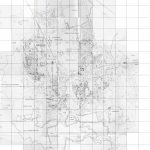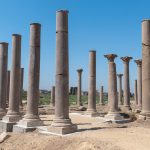AL-AŠMŪNAYN (HERMOUPOLIS MEGALĒ)
| Egyptian | Ḫmnw |
| Greek | Ἑρμοῦ πόλις Μεγάλη | Ἑρμοπολιτῶν πόλις |
| Coptic | ¥moun | ¥moun(in) | smoun |
| Arabic | الأشمونين |
| English | Hermopolis Magna | el-Ashmunein |
| French | Hermoupolis Magna | Hermopolis Magna | el-Achmounein | Achmounein | Achmouneyn |
| German | el-Aschmunein |
| DEChriM ID | 30 |
| Trismegistos GeoID | 816 |
| Pleiades ID | 756574 | PAThs ID | 28 |
| Ancient name | Hermoupolis Megalē |
| Modern name | al-Ašmūnayn |
| Latitude | 27.7796202493 |
| Longitude | 30.8035806072 |
| Date from | - |
| Date to | - |
| Typology | City |
| Dating criteria | - |
| Description | Hermopolis Magna, modern day al-Ašmūnayn, is situated on the western bank of the Nile, 40km south of al-Minyā and 7km north of Mallawī (Maehler, 2012: 1). Known as ‘Khumu’ in the Pharaonic period, which became ‘Shmun’ in Coptic, it was the principal seat of worship of the Egyptian god Thoth, who the Greeks identified with Hermes, thus calling the city Hermopolis (Wace et al. 1959: 1). In order to differentiate it from a ‘Hermopolis’ in the Delta, it became known as Hermopolis Magna (Wace et al. 1959: 1). The necropolis of Tūna al-Ǧabal is associated with the site, and contains extensive cemeteries dedicated to baboons and ibises, both of which are representative of the god Thoth (Atiya, 1991: 285). The necropolis is so extensive, however, that it is considered an archaeological site in its own right. During the Pharaonic period, the site was the capital of the 15th Upper Egyptian nome. Most of the area that has so far been cleared and surveyed was dedicated to temples and other public buildings. The account of the building repairs of 263/7 mention temples of Sarapis, Hadrian, Antinoos, Tyche, and Aphrodite (Maehler, 2012: 1). During the Roman period, the city was divided into four quarters, ‘citadel’ east and west, and ‘town’ east and west. Each of these areas were divided by a colonnaded street running from the sun-gate in the east to the moon-gate in the west, also known as ‘Antinoe Street’, which was crossed by the Dromos of Hermes, a road commissioned by Nectanebo I (378-360 BCE) (Maehler, 2012: 1). In more or less the center of the ruins of the town is an area denoted Kūm al-Kanīsa. This space was considered by earlier explorers to have been an agora, a classification which went unchallenged for quite some time. This was until the excavations conducted by the Service des Antiquités in the mid-1940s revealed that the structure was in fact a Christian basilica built on top of at least four Ptolemaic buildings, including a temple dedicated to Ptolemy III and his wife Berenike (Wace et al. 1959: 5). Based on an inscription uncovered in the 1940s, the temple was likely constructed at the beginning of Ptolemy’s reign, perhaps 246 BCE and likely no later than 240 (Wace et al. 1959: 4). Hermopolis Magna is known to have been an episcopal see from the second half of the third century. According to tradition, this is where the Holy Family reached the end of its journey. The Christian occupation of the side is well-documented, with a bishop present until the end of the 13th century (Stillwell et al. 1976: 1). Much of the architectural elements related to the ancient structures were reused in the construction of mosques. Basilica South Church Alongside these two churches, there are an additional seven others, as well as a monastery dedicated to Saint Severus, which are known by name and partly by location (Atiya, 1991: 285). A later account (6th-8th century) relating to the taxation of certain churches in Hermoupolis and its surroundigs (P.Lond.Copt. 1100) records five of these churches that were dedicated to the Virgin. One (or perhaps two) of these is described by Abū al-Makārim in the 13th century (Evetts, 1895: 76b and 77a). |
| Archaeological research | The site is known to have been visited by Napoleon’s savants, who found a portico of twelve columns still standing, understood to have belonged to the Temple of Thoth, which was completed in the reign of Philip III Arrhidaeus (323-317 BC). A German expedition was carried out in 1929 under the direction of Günther Roeder, which focused predominantly on studying the topography, while conducting limited work in the so-called ‘agora’. This was followed by the work of the Service des Antiquités, who in 1939, under the direction of Émile Baraize, cleared and re-erected a number of columns of the ‘tetrastyle’ on the northern side of the ‘agora’ (against Antinoe road). In 1942, the work of the Service des Antiquités was led by Muḥarram Kamāl, who initiated extensive clearance of the whole ‘agora’. Baraize began reconstruction on the ‘agora’, which both he and Kamāl recognised as a Christian basilica (Wace et al. 1959: 1). At the same time, in 1945, Rizq-Allāh Naǧīb Makram-Allāh, a lecturer from Alexandria University, carried out further clearance on the north and west sides, where he supposedly found Pharaonic walls of unbaked brick, which on the west side ran beneath the narthex, and on the west side were far below the Ptolemaic level. While a number of photographs were taken, he left no documentation or plans regarding these structures, and they were destroyed by the elements soon after they were uncovered (Wace et al. 1959: 2). Baraize uncovered many pieces of painted architecture of the Ptolemaic period, as well as the inscription which showed that the Ptolemaic building the basilica was built on top of was dedicated to Ptolemy III and his wife Berenike (Wace et al. 1959: 2). The University of Alexandria conducted work in August and September of 1949, and the following year, in 1950, the team was joined in March and April by A. H. S. Megaw, Director of Antiquities of Cyprus. Supplementary work was carried out in December 1950 and September 1951 (Wace et al. 1959: 3). This work, which resulted in the clearing of the whole structure, was very much in line with other work conducted in the mid-twentieth century, with limited records, and no analysis of archaeological context. The British Museum ran excavations between 1983 and 1989, resulting in a number of monographs. Between 1987 and 1990, a joint Polish-Egyptian team conducted work on the site’s basilica. This work, comprising both archaeological and conservational fieldwork, was led by Marek Barański in association with the Center of Mediterranean Archaeology of the University of Warsaw, Przedsiębiorstwo Państwowe Pracownie Conservacji Monuments (PP PKZ) (State Ateliers for the Preservation of Cultural Heritage) and the Egyptian Antiquities Organisation. |
• Atiya, A. S. 1991. “Ashmunein.” In The Coptic Encyclopedia, edited by A. S. Atiya, New York: Macmillan Publishers. 285-287.
• Badawy, A. 1958. “The Cemetery at Hermopolis West.” Archaeology 11: 117-22.
• Bailey, D. M. 1982. “A Late Roman Building and a Wine Press.” British Museum Occasional Paper 32: 11-18.
• Bailey, D. M. 1991. Excavations at el-Ashmunein IV: Hermopolis Magna: Buildings of the Roman Period. London: British Museum Press.
• Bailey, D. M. 1998. Excavations at el-Ashmunein V. Pottery, Lamps and Glass of the Late Roman and Early Arab Period. London: British Museum Press.
• Bailey, D. M., W. V. Davies, and A. J. Spencer. 1982. “Ashmunein (1980).“ British Museum Occasional Paper 37: 11-19.
• Bailey, D. M. and P. Grossmann 1994. “The South Church at Hermopolis Magna (Ashmunein): A Preliminary Report.” In Churches Built in Ancient Times: Recent Studies in Early Christian Archaeology, edited by K. Painter, 49-71. London: Accordia Research Centre.
• Baraize, E. 1940. ““L’Agora” d’Hermoupolis.” Annales du Service des antiquités de l'Égypte 40: 741-745.
• Barański, M. 1990. “Preserving the Christian Basilica of El-Ashmunein.” Bulletin de l'Institut français d'archéologie orientale 90: 41-49.
• Barański, M. 1992. “Excavations at the Basilica Site at el-Ashmunein/Hermopolis Magna in 1987-1990.” Polish Archaeology in the Mediterranean 3: 19-23.
• Becker, C. H. A. 1912. ”El-Ashmunain.” Eretz Israel: Archaeological, Historical and Geographical Studies 1: 502-503.
• Bittel, K. and A. Hermann. 1934. “Grabungsbericht Hermopolis 1933.” Mitteilungen des Deutschen Archäologischen Instituts, Abteilung Kairo 5: 11-44.
• Clédat, J. 1902. “Notes archéologiques et philologiques, IV: Ashmounein.” Bulletin de l'Institut français d'archéologie orientale 2: 41-70.
• Clédat, J. 1907. “Notes d’archéologie copte: Ashmounein.” Annales du Service des antiquités de l'Égypte 9: 230.
• Effendi Chaban, M. 1907. “Fouilles à Achmounein.” Annales du Service des antiquités de l'Égypte 8: 211-223.
• El-Khachab, A. 1955. “Numismatica.” Annales du Service des antiquités de l'Égypte 53/2: 251-278.
• Evetts, B. T. A. ed. 1895. Churches and Monasteries of Egypt and Some Neighbouring Countries. Attributed to Abû Ṣâliḥ, the Armenian. London: Oxford University Press. 218-222.
• Grohmann, A. 1939. “Contribution to the Topography of Al-Ushmûnain from Arabic Papyri.” Bulletin de l’Institut d’Égypte 21: 211-214.
• Grossmann, P. 1989. “Neue frühchristliche Funde aus Ägypten.” In Actes du XIe congrès international d’archéologie chrétienne. Lyon, Vienne, Grenoble, Genève, Aoste, 21-28 septembre 1986. Rome: École Française de Rome, 1989: 1873-1875.
• Grossmann, P. 2002. Christliche Architektur in Ägypten. Leiden: Brill. 437-441.
• Hemeda, S., A. Fahmy, A. Moustafa and M. A. El Hafez. 2019. “The Early Basilica Church, El-Ashmonein Archaeological Site, Minia, Egypt: Geo-Environmental Analysis and Engineering Characterization of the Building Materials.” Open Journal of Geology 9: 157-186.
• Kamal, M. 1947. “Excavations on the Antiquities Department (1942) in the so-called “Agora” of Hermopolis (Ashmunain).” Annales du Service des antiquités de l'Égypte 46: 289-295.
• Karig, J. S. 1961. “Hermopolis 1959, Bericht über die photographische Arbeit in Ashmunein.” Mitteilungen des Deutschen Archäologischen Instituts, Abteilung Kairo 17: 128-130.
• Mälher, H. 1974. Papyri aus Hermopolis. Berlin.
• Maehler, H. 2012. “Hermopolis Magna (Greco-Roman)“. In The Encyclopedia of Ancient History, edited by R. S. Bagnall, Malden, MA: Wiley-Blackwell.
• Meautis, G. 1918. Hermopolis-La-Grande. Lausanne.
• Roeder, G. 1937. “Bericht über die Ausgrabungen der Deutschen Hermopolis-Expedition 1935.” Mitteilungen des Deutschen Archäologischen Instituts, Abteilung Kairo 7: 1-56.
• Roeder, G. 1938. “Die Ausgrabungen in Hermopolis im Frühjahr 1938.” Annales du Service des antiquités de l'Égypte 38: 435-453.
• Roeder, G. 1939. “Die Ausgrabungen in Hermopolis im Frühjahr 1939.” Annales du Service des Antiquités de l'Égypte 39: 727-747.
• Roeder, G. 1951. Ein Jahrzehnt deutscher Ausgrabungen in einer ägyptischen Stadtruine. Deutsche Hermopolis-Expedition 1929-1939. Hildesheim: Gerstenberg.
• Roeder, G. 1959. Hermopolis 1929-1939, Aussgrabungen der Deutschen Hermopolis-Expedition in Hermopolis, Ober-Ägypten, in Verbindung mit zahlreichen Mitarbeitern. Hildesheim: Gerstenberg.
• Roeder, G. 1969. Amarna-Reliefs aus Hermopolis. Hildesheim: Gerstenberg.
• Ronczewski, K. 1936. “Kapitellfragmente aus Hermopolis 1933.” Mitteilungen des Deutschen Archäologischen Instituts, Abteilung Kairo 6: 88-102.
• Schmitz, H. 1934. “Die Bau-Urkunde in P. Vindob. G 12565 im Lichte der Ergebnisse der deutschen Hermopolis-Expedition.“ Münchener Beiträge zur Papyrusforschung und antiken Rechtsgeschichte 19: 406-428.
• Snape, S. R. 1989. A Temple of Domitian at El-Ashmounein. British Museum Expedition to Middle Egypt. London: British Museum Press.
• Spencer, A. J. 1982. The Possible Existence of Third Intermediate Period Elite Tombs at El-Ashmunein. London: British Museum Press.
• Spencer, A. J. 1983. Excavations at el-Ashmunein I: The Topography of the Site. London: British Museum Press.
• Spencer, A. J. 1989. Excavations at el-Ashmunein II: The Temple Area. London: British Museum Press.
• Spencer, A. J. 1993. Excavations at el-Ashminein III: The Town. London: British Museum Press.
• Stillwell, R., W. L. MacDonald and M. H. McAlister. 1976. The Princeton Encyclopedia of Classical Sites. Princeton, N.J. Princeton University Press.
• Timm, S. (ed.) 1984-1992. Das Christliche-Koptische Ägypten in Arabischer Zeit: Eine Sammlung Christicher Stätten in Ägypten in Arabischer Zeit unter Ausschyss von Alexandria, Kairo, des Apa-Mena-Klosters (Der Abu Mina), der Sketis (Wadi n-Natrun) und der Sinai-Region. vol 1. Weisbaden: Dr Ludwig Reichert.
• Wace, A. J. B., A. H. S. Megaw and T. C. Skeat. 1959. Hermopolis Magna, Ashmunein: the Ptolemaic Sanctuary and the Basilica. Alexandria: Alexandria UNiversity Press.
• William Smith, L. L. D. 1854. Dictionary of Greek and Roman Geography. London: Walton and Maberly.


 Json data
Json data







